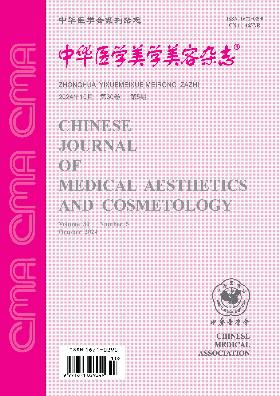冷冻保存大鼠脂肪颗粒自体移植后的存活率
引用次数: 0
摘要
目的观察不同低温条件下脂肪颗粒在自体移植中的存活情况。方法3组成年Wistar大鼠分别注射新鲜的自体脂肪颗粒,分别在80℃和196℃下保存2个月,在移植后1个月和2个月对其体积、平行组织学检测、葡萄糖转运测量、MTT实验等数据进行比较分析。结果移植1个月后,注射新鲜自体脂肪颗粒组移植体存活率高于注射80℃保存的自体脂肪颗粒组和注射196℃保存的自体脂肪颗粒组(P<0.05);移植后2个月,三组间差异无统计学意义。移植前,80℃和196℃保存2个月后的自体脂肪颗粒活性分别为新鲜自体脂肪颗粒的68.7%和62.5%。移植1个月后,我们发现新鲜组的自体脂肪颗粒活性高于196℃和80℃,而196℃和80℃贮藏组之间无显著差异。移植2个月后,新鲜组的自体脂肪颗粒活性高于196℃和80℃组。移植前,三组间脂肪组织学颗粒无显著差异。移植后1个月,三组均可见脂肪空泡及明显的炎症浸润,其中80℃保存组影响最严重。移植2个月后,196℃保存的新鲜脂肪颗粒和组中有大量致密的完整脂肪细胞,分散在脂肪液泡中心周围,而80℃保存的组中仍有大量脂肪液泡,但脂肪液泡明显融合。结论在80℃和196℃条件下储存的脂肪能在短时间内满足临床使用的需要。196℃贮藏的脂肪活性最好。在196℃下储存的脂肪颗粒可用于建立良好的血液循环。脂肪移植后1个月移植区炎症反应最重,移植颗粒活性下降最明显。关键词:大鼠;低温贮藏;防冷冻的代理;脂肪粒;细胞活性本文章由计算机程序翻译,如有差异,请以英文原文为准。
Survival rate of cryopreserved rat fat granuales after autologous transplantation
Objective
To observe the fat particles survival situations in autologous transplantation under different conditions of low temperature.
Methods
Three sample groups of adult Wistar rats were injected with fresh autologous fat particles, which were stored under 80 ℃ for two months and under 196 ℃ for two months respectively, and the volume, parallel histological detection, glucose transport measurement, MTT experiments and other data were compared and analyzed one month and two months after the transplantation.
Results
One month after transplantation, graft survival rate was higher in Group injected fresh autologous fat particles than that of Group injected autologous fat particles stored under 80 ℃ and Group injected autologous fat particles stored under 196 ℃ (P<0.05); Two months after transplantation, the differences among three groups had no statistical significance. Before the transplantation, the activity of autologous fat particles stored in 80 ℃ and 196 ℃ were 68.7% and 62.5% of fresh autologous fat particles, respectively, two months after cryopreservation. One month after the transplantation, we found that the activities of autologous fat particles were higher in fresh group than that of 196 ℃ and 80 ℃, There was no significant difference between the groups stored in 196 ℃ and 80 ℃. Two months after the transplantation, the activities of autologous fat particles were higher in fresh group than that of 196 ℃ and 80 ℃. Before transplantation, the particles of fat histology showed no significant difference among three groups. One month after transplantation, fat vacuoles and distinct inflammatory infiltration were observed in all three groups, with the group stored in 80 ℃ as the most serious affected. Two months after transplantation, fresh fat particles and Group stored in 196 ℃ showed large quantity of tightly packed intact fat cells, scattered around the central area in fat vacuoles, while Group stored in 80 ℃ still had a large quantity of fat vacuoles, but the fat vacuoles were obviously fused.
Conclusions
The fat stored at80 ℃ and196 ℃ could meet the needs of clinical use in the short time. The fat stored at 196 ℃ shows the best activity. The fat particles stored at196 ℃ could be used to establish better blood circulation. The heaviest inflammatory reaction occurs in the graft zone one month after fat transplantation and the decrease of transplanted particle activity is the most obvious.
Key words:
Rats; Cryopreservation; Cryoprotective agents; Fat granule; Cell activity
求助全文
通过发布文献求助,成功后即可免费获取论文全文。
去求助
来源期刊
自引率
0.00%
发文量
4641
期刊介绍:
"Chinese Journal of Medical Aesthetics and Cosmetology" is a high-end academic journal focusing on the basic theoretical research and clinical application of medical aesthetics and cosmetology. In March 2002, it was included in the statistical source journals of Chinese scientific and technological papers of the Ministry of Science and Technology, and has been included in the full-text retrieval system of "China Journal Network", "Chinese Academic Journals (CD-ROM Edition)" and "China Academic Journals Comprehensive Evaluation Database". Publishes research and applications in cosmetic surgery, cosmetic dermatology, cosmetic dentistry, cosmetic internal medicine, physical cosmetology, drug cosmetology, traditional Chinese medicine cosmetology and beauty care. Columns include: clinical treatises, experimental research, medical aesthetics, experience summaries, case reports, technological innovations, reviews, lectures, etc.

 求助内容:
求助内容: 应助结果提醒方式:
应助结果提醒方式:


